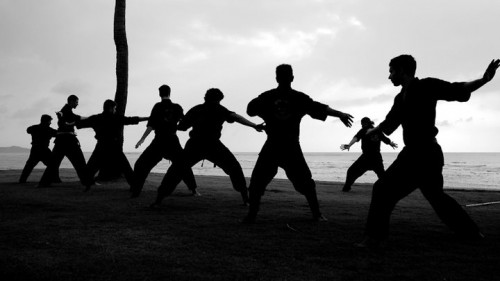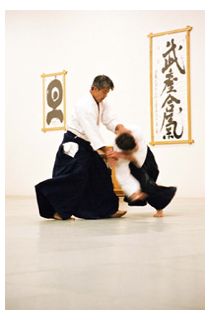
People who develop mindfulness are pretty tough to mess with.
Maybe you’ve discovered this before, after messing with the wrong person one time and learning a painful and heart opening lesson. Maybe it was the other way around.
Mindfulness is a powerful force that can be used for what many in metaphysical circles call “psychic self-defense.” It can be likened to a martial art that can transform any conflict or uncomfortable social situation into a catalyst for deep healing. It can also protect us from any harm a person can inflict if used properly.
First let me explain, in case some readers don’t know, what mindfulness is. Mindfulness is the art of being present with moment to moment experience as it arises into consciousness. This includes both pleasant and unpleasant emotions, thoughts, sensations and anything else that can be experienced.
When we’re not mindful, our breath is easily affected in difficult situations. When an experience is unpleasant, we may restrict our breathing to avoid feeling it. We may become reactive to a person because we fear experiencing difficult truths about ourselves.
In some cases, we might start a conflict because there is some truth about ourselves that the ego doesn’t want to experience and we project that quality onto the other person. We may even escalate a conflict because of resentment of our current experience with the person. We are much more vulnerable to the negativity coming from others.
With mindfulness, the breath is deep and free. During unpleasant situations, it remains unaffected. We are not burying any unpleasant information about ourselves. We are simply noting what is going on while still participating with what is going on. There is nothing to resent. Everything is just a set of processes happening in the moment, and we are joyfully embracing them whether we’re angry, sad or scared.
Most of the tension in our bodies comes from being unwilling to confront and experience something. There may be old wounds or feelings that the ego feels are best left untouched. Tension allows us to avoid experience.
Mindfulness allows us to open to experience and to shine the light of awareness on unresolved issues. A tension point in the body-mind is like a wall that creates separation instead of flow. Mindfulness breaks down these walls so that consciousness can start flowing. The less walls obstruct the flow, the more whole we become. There is less division in the body-mind.
Here’s where the ninja stuff comes in.
When the “antagonist” walks into the scene, what is his or her job?
The antagonist’s (or perceived antagonist’s) job is to find some tension within us and shake things up. Even stalkers, rapists and robbers will at least subconsciously look for certain weaknesses, certain points of tension that correspond with the antagonist’s own weakness.
Have you ever had a series of people treating you in a negative way? One of them leaves your life, and then another one pops up and treats you in the same way?
If this situation is in the past and no one’s bothering you in that way anymore, then maybe you notice that there was some tension you were holding then that doesn’t seem to exist now. There was some part of yourself that you finally “faced”, even if it was in gradual increments.
It may have taken years for you to get to that point where you finally cleared the issues that people and situations were exploiting. Mindfulness accelerates this process. It allows you to really heal yourself on a deep level and “kick some ass” at the same time.
Every interaction is an opportunity for healing.
In both peaceful and uncomfortable situations, when we heal long held tension and release it, we are actually helping the others to release their corresponding tension. In a tense situation, it is this that is going to bring a serious butt whoopin’ to the opponent while healing both ourselves and the opponent at the same time.
All of this works via subtle processes. There are very subtle processes that brought the two “opponents” (for lack of a better term) together in the first place.
We can use woo-woo terms to describe this, but I really don’t believe in the “supernatural”. There are just natural processes that our compartmentalized brains are generally not used to perceiving without proper training and brain synchronization.
These same subtle forces may lead us to a series of romantic partners with similar illnesses, disorders and imbalances. They may also lead us to a series of bullies, each with the same underlying issue that has some polar connection with our own.
From a holistic perspective, these antagonists are helping us resolve our issues and clear tension so that we won’t have to repeat such painful experiences again. They actually make it easier to heal ourselves. After all, when they’re not around, we’re not going to be nearly as aware of the tension we are holding.
When we use this opportunity wisely and begin to heal our tension, even just a little bit, we are actually forcing them to do the same. If we enter the “battle” with a spirit of mindfulness and humility, they will never know what hit them.
Most of the time, they are used to a response of resentment, polarization and reinforcement of inner tension within both parties. These are the types of responses ego wants. That ego just wants to control others and change others. The real person behind the ego, however, is asking for healing. It requires mindfulness to break the cycle once and for all.
We’ve been a little abstract so far. Here’s a breakdown on how put it into action. There is also a story below to illustrate.
Body Sensations
For all practical purposes, every person is an experience inside yourself. Their external form is mainly an interpretation by your brain based on what information your brain finds useful enough to allow into consciousness. A bacterium is going to look at the same person and see something entirely different in terms of its desires and what its nervous system finds useful.
Neither human nor bacterial consciousness is 100 percent objective. Utility is boss by default.
 What we do have to work with is the inner experience of everyone we’re dealing with. There are always body sensations that come up when we’re dealing with people. Some are very pleasant, some are not very pleasant and some just plain spook us out.
What we do have to work with is the inner experience of everyone we’re dealing with. There are always body sensations that come up when we’re dealing with people. Some are very pleasant, some are not very pleasant and some just plain spook us out.
One key to applying mindfulness is to embrace the experience that is happening inside us. This will provide clues about the subtle connection that is bonding us together at the moment and the tension we are holding.
Suppose your recurring problem is people talking over you all the time. Every time someone talks over you while you are attempting to speak, certain feelings come up.
By applying mindfulness, you are more acutely aware of the tension that you’ve been holding—the tension that leads to these experiences in the first place. These sensations are clues that point to what needs to be embraced and willfully experienced to break the cycle.
If you fear public speaking, feelings also come up when you walk up to the podium. You may be immobilized by the inability to embrace the experience fully.
There have been many cases when someone finally faced the experience and had a huge breakthrough. Not only did they become much more comfortable and loose onstage, but they released a whole lot of old tension that won’t stand in their way ever again. They felt much lighter after the breakthrough. This is the kind of thing we’re aiming for.
Paying attention to body sensations is an essential step to breaking negative recurring cycles. In the above examples, there is the experience the ego is resisting, and the resistance is always a form of tension. Let go of the tension, and the recurring unpleasant experience will disappear.
If the unpleasant situation is triggered by other people, then either those people will disappear or their underlying issues that lead to our pain will disappear. Whatever the case, we will not keep experiencing it if we let go of that tension, whether gradually or all at once.
Breath
Always remember not to let anything obstruct your breathing. A scolding boss, an annoying neighbor, a manipulative spouse, a grease fire on the stove—nothing.
A lack of smooth breath is a lack of smooth awareness. It is the perpetuation of tension and the perpetuation of those situations, that restriction of breath is an attempt to avoid.
It’s so much easier to respond to the demands of the moment when we’re not running away from the moment. Smooth breath will help us become present enough to grab exactly what we need, where we need it and throw it on that grease fire. It will also help ensure we are present enough to respond to an argument in the most appropriate way, so that tension is released within both parties rather than reinforced.
Smooth breathing will allow for the experience of more feeling in the body and therefore, an easier time processing emotional issues and healing them.
Practice diaphragmatic breathing in all types of situations. Breathe through the nose and imagine the abdomen being like a balloon. That balloon should expand in all directions—toward the ribs, toward the groin, forward and backward. The breath should be felt in the belly as well as the back.
There are times when we may need to breathe more heavily and more shallowly than normal. With mindfulness, we’ll know how to breathe in each situation as it arises.
Grounding
When we’re feeling grounded, we are more connected with the body. There is a greater flow of feeling in the body. Therefore, grounding will help us process whatever emotions and experiences that are arising in the moment. It will also help us process undigested experience that the ego has previously buried. This includes the “stuff” that comes to the surface in a heated situation with another person.
When you’re not experiencing negative interactions and recurring unpleasant situations, practice some grounding exercises. There are visualizations for this as well as yoga postures and many other activities that help us connect with the body.
With regular practice, we’re on much better footing in an unpleasant encounter. We’re much more likely to catalyze a profound healing within the self and the other.
In an intense encounter, we can practice grounding by being as present as possible with the Earth below us and the sky above us. Feel the ground with your feet and embrace the sky. This will greatly increase your ability to transform the encounter into one of healing.
Cultivating Mindfulness Regularly
There was a controlled study of the long term effects of meditation practice. It included two groups. One was a group of monks, associated with the Dalai Lama, each with at least 10,000 hours of meditation experience behind them. The other was a group of novice meditators.
The team used Functional MRI brain scan technology that measures, in real time, real activity in the brain. All participants practiced compassion meditation during the study.
Everyone was showing increased activity in the left prefrontal cortex, the region associated with positive emotions. A circuit that responds to the perception of suffering in others also showed increased activity. Gamma activity increased, and this was revealed by EEG’s which measure brainwaves. Gamma waves are associated with “higher consciousness”. There were other brain changes as well.
All the changes in the brain during the meditation were much greater and much more pronounced in the experienced monks than in the novices. This suggests a cumulative effect. These monks developed a lot of gray matter in these areas of the brain, and this gray matter corresponds with a higher concentration of synapses which connect neurons to each other.
If you’ve been meditating for a while, you’re probably saying “duh.” Science is a bit slower than pure consciousness. Einstein’s theories began with flashes of insight. The science came later.
The more you practice meditation, the greater your ability to transform all types of conflict into healing opportunities in any given moment. Your access to a spacious and all-embracing consciousness will become easier in each situation as time goes on.
“First take the log out of your own eye, and then you will see clearly to take the speck out of your brother’s eye.”
~ Matthew 7:5 English Standard Version
Jesus wasn’t saying that if you get rid of your own blemish, then you have a right to judge your brother. When you release your own tension, you’ll catalyze great healing in the other person and perhaps even force it without trying. After that, you may run into someone else who has the same problem. Instead of running into more problems, you are now in the position to help them overcome theirs.
Regular cultivation of mindfulness is the key to clearing the log and the speck.
Here’s a story that puts all these principles into practice.
I was working in a 24-hour gas station on the graveyard shift. A man walks in at perhaps 2-3:00 a.m. He was a black man who was probably somewhere in his twenties.
The payphone was broken, and he wanted to use the store’s cordless phone. It turned out to be out of juice. He became furious and started to cuss me out. Then he walked toward the door.
I was mindful enough at the time to sense that there was unfinished business. So, I knew to get the last word in. Otherwise, it would have been better to let him leave and say goodbye to the situation. I said something very assertively, without being mean, that affirmed my dignity as a human being and made a good case.
His response: He turned right back around and stared me down.
I can only speculate, but it appeared that his weakness that was causing tension, was the fear of getting the short end of the stick. This lead to aggressive behavior. My weakness was a fear of entering conflict in the first place. This lead to passive behavior.
How was I to deal with this?
I had been chanting during the entire shift, and my level of mindfulness was very high as a result. When scrubbing coffee pots, chanting. Between counting money and punching in numbers, chanting (as much as possible anyway). When filling the cooler, chanting. This really prepared me for the encounter.
I was aware that I needed to truly feel, within my body, what was going on in the moment and open up to the experience. I kept the breathing deep and smooth. I embraced Earth and sky.
Responding to the reality of the moment became easy in this tense situation. My fear of conflict melted as I became more assertive. I had a deeper intuitive sense of what to do and how much to do, without creating a dangerous situation.
It felt great. If I had polarized the situation, it would have been more painful for both parties. It may even have become physical. All this tension within me melted, and it was blissful. It really felt like this guy came as an angel in disguise, to partner with me in a healing experience.
I felt rather thankful and had a sudden feeling that I should offer him a free drink such as a coffee. His heart immediately opened up and there were actually some tears. All he could say was “you a good person” repeatedly.

Because I went through this mindfulness protocol, not only was I healed, but he was forced to release a whole lot of age old tension as well. This is actually an extension of martial arts that is embodied in the principles of Aikido, a martial art that emphasizes the inward harmonizing with conflict. You can call it the “knock-out punch” if you like.
We both went outside and indulged in an evil freebase substance called tobacco. He actually said that, at one point, he thought I was going to pull out a gun and shoot him.
I was actually just mirroring his anger energy, while transmuting it with mindfulness. I certainly wasn’t nice. I was just doing what I needed to do to become more whole in that moment.
This principal is hard to explain. The way to really learn it is through experiential training on the field. You may know exactly what I’m talking about, but only if you’ve actually experienced it in one way or another.
Then, one of the local home bums stopped in. The two of them hit it off, as they had similar backgrounds and interests. They left the store together to engage in unnamed naughty activities. Not only did the two of us have polarities that attracted us to each other for a purpose, but so did they. Their mission as a duo just happened to be a little different on the soul level.
It wasn’t the external act of being nice with an offer of coffee that transformed the entire situation. He saw it in my eyes and knew that something was happening on a very subtle level. This is because I was practicing all the principles mentioned here and cultivating mindfulness throughout the shift.
We’re taught that our internal actions are separate from the external ones. Think all the vitriolic thoughts you want but be polite, we’re often told. Mindfulness helps us realize that our inner and outer actions are one action, not two.
The external effects of our inner actions may be subtle more often than not, but countless stories like the one above prove that the effect of mindfulness can be very profound. It may even radically transform the lives of those we interact with for the better.
If you’ve been spending time cultivating mindfulness, try putting some of these principles into practice. You may deepen your understanding of the link between meditation and martial arts.
Open up a can of whoop-ass and champion the cause of peace.
Love elephant and want to go steady?
Sign up for our (curated) daily and weekly newsletters!
Editorial Assistant: Cami Krueger / Editor: Catherine Monkman
Photo: elephant archives

 Share on bsky
Share on bsky






Read 0 comments and reply